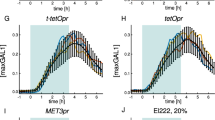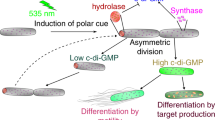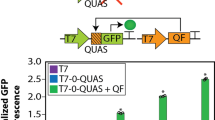Abstract
Certain types of cellular differentiation are probabilistic and transient1,2,3. In such systems individual cells can switch to an alternative state and, after some time, switch back again. In Bacillus subtilis, competence is an example of such a transiently differentiated state associated with the capability for DNA uptake from the environment. Individual genes and proteins underlying differentiation into the competent state have been identified4,5, but it has been unclear how these genes interact dynamically in individual cells to control both spontaneous entry into competence and return to vegetative growth. Here we show that this behaviour can be understood in terms of excitability in the underlying genetic circuit. Using quantitative fluorescence time-lapse microscopy, we directly observed the activities of multiple circuit components simultaneously in individual cells, and analysed the resulting data in terms of a mathematical model. We find that an excitable core module containing positive and negative feedback loops can explain both entry into, and exit from, the competent state. We further tested this model by analysing initiation in sister cells, and by re-engineering the gene circuit to specifically block exit. Excitable dynamics driven by noise naturally generate stochastic and transient responses6, thereby providing an ideal mechanism for competence regulation.
This is a preview of subscription content, access via your institution
Access options
Subscribe to this journal
Receive 51 print issues and online access
$199.00 per year
only $3.90 per issue
Buy this article
- Purchase on Springer Link
- Instant access to full article PDF
Prices may be subject to local taxes which are calculated during checkout





Similar content being viewed by others
References
Dupin, E., Real, C., Glavieux-Pardanaud, C., Vaigot, P. & Le Douarin, N. M. Reversal of developmental restrictions in neural crest lineages: transition from Schwann cells to glial-melanocytic precursors in vitro. Proc. Natl Acad. Sci. USA 100, 5229–5233 (2003)
Lee, E. J., Russell, T., Hurley, L. & Jameson, J. L. Pituitary transcription factor-1 induces transient differentiation of adult hepatic stem cells into prolactin-producing cells in vivo. Mol. Endocrinol. 19, 964–971 (2005)
Meeks, J. C., Campbell, E. L., Summers, M. L. & Wong, F. C. Cellular differentiation in the cyanobacterium Nostoc punctiforme. Arch. Microbiol. 178, 395–403 (2002)
Grossman, A. D. Genetic networks controlling the initiation of sporulation and the development of genetic competence in Bacillus subtilis. Annu. Rev. Genet. 29, 477–508 (1995)
Hamoen, L. W., Venema, G. & Kuipers, O. P. Controlling competence in Bacillus subtilis: shared use of regulators. Microbiology 149, 9–17 (2003)
Lindner, B., Garcia-Ojalvo, J., Neiman, A. & Schimansky-Geier, L. Effects of noise in excitable systems. Phys. Rep. 392, 321–424 (2004)
Hahn, J., Kong, L. & Dubnau, D. The regulation of competence transcription factor synthesis constitutes a critical control point in the regulation of competence in Bacillus subtilis. J. Bacteriol. 176, 5753–5761 (1994)
Hahn, J., Luttinger, A. & Dubnau, D. Regulatory inputs for the synthesis of ComK, the competence transcription factor of Bacillus subtilis. Mol. Microbiol. 21, 763–775 (1996)
van Sinderen, D. et al. comK encodes the competence transcription factor, the key regulatory protein for competence development in Bacillus subtilis. Mol. Microbiol. 15, 455–462 (1995)
van Sinderen, D. & Venema, G. comK acts as an autoregulatory control switch in the signal transduction route to competence in Bacillus subtilis. J. Bacteriol. 176, 5762–5770 (1994)
Maamar, H. & Dubnau, D. Bistability in the Bacillus subtilis K-state (competence) system requires a positive feedback loop. Mol. Microbiol. 56, 615–624 (2005)
Smits, W. K. et al. Stripping Bacillus: ComK auto-stimulation is responsible for the bistable response in competence development. Mol. Microbiol. 56, 604–614 (2005)
Turgay, K., Hahn, J., Burghoorn, J. & Dubnau, D. Competence in Bacillus subtilis is controlled by regulated proteolysis of a transcription factor. EMBO J. 17, 6730–6738 (1998)
Ogura, M., Liu, L., Lacelle, M., Nakano, M. M. & Zuber, P. Mutational analysis of ComS: evidence for the interaction of ComS and MecA in the regulation of competence development in Bacillus subtilis. Mol. Microbiol. 32, 799–812 (1999)
Rosenfeld, N., Young, J. W., Alon, U., Swain, P. S. & Elowitz, M. B. Gene regulation at the single-cell level. Science 307, 1962–1965 (2005)
Ozbudak, E. M., Thattai, M., Kurtser, I., Grossman, A. D. & van Oudenaarden, A. Regulation of noise in the expression of a single gene. Nature Genet. 31, 69–73 (2002)
Elowitz, M. B., Levine, A. J., Siggia, E. D. & Swain, P. S. Stochastic gene expression in a single cell. Science 297, 1183–1186 (2002)
Haijema, B. J., Hahn, J., Haynes, J. & Dubnau, D. A. ComGA-dependent checkpoint limits growth during the escape from competence. Mol. Microbiol. 40, 52–64 (2001)
Serror, P. & Sonenshein, A. L. CodY is required for nutritional repression of Bacillus subtilis genetic competence. J. Bacteriol. 178, 5910–5915 (1996)
Nakano, M. M. & Zuber, P. The primary role of comA in establishment of the competent state in Bacillus subtilis is to activate expression of srfA. J. Bacteriol. 173, 7269–7274 (1991)
Hahn, J. & Dubnau, D. Growth stage signal transduction and the requirements for srfA induction in development of competence. J. Bacteriol. 173, 7275–7282 (1991)
Isaacs, F. J., Hasty, J., Cantor, C. R. & Collins, J. J. Prediction and measurement of an autoregulatory genetic module. Proc. Natl Acad. Sci. USA 100, 7714–7719 (2003)
Xiong, W. & Ferrell, J. E. Jr. A positive-feedback-based bistable ‘memory module’ that governs a cell fate decision. Nature 426, 460–465 (2003)
Pomerening, J. R., Kim, S. Y. & Ferrell, J. E. Jr. Systems-level dissection of the cell-cycle oscillator: bypassing positive feedback produces damped oscillations. Cell 122, 565–578 (2005)
Lahav, G. et al. Dynamics of the p53-Mdm2 feedback loop in individual cells. Nature Genet. 36, 147–150 (2004)
Hardin, P. E. The circadian timekeeping system of Drosophila. Curr. Biol. 15, R714–R722 (2005)
Vilar, J. M., Kueh, H. Y., Barkai, N. & Leibler, S. Mechanisms of noise-resistance in genetic oscillators. Proc. Natl Acad. Sci. USA 99, 5988–5992 (2002)
Keener, J. & Sneyd, J. Mathematical Physiology (Springer, New York, 1998)
Acknowledgements
We thank U. Alon, D. Dubnau, J. Dworkin, A. Eldar, J. Ferrell, R. Kishony, B. Lazazzera, R. Losick, A. Raj, B. Shraiman, D. Sprinzak, M. Surette and members of the laboratory for comments. G.M.S. is supported by the Caltech Center for Biological Circuit Design. J.G.-O. acknowledges financial support from the Generalitat de Catalunya and the Ministerio de Educacion y Ciencia (Spain). M.B.E. acknowledges support from the Searle Scholars Program and the Burroughs Wellcome Fund CASI program.
Author information
Authors and Affiliations
Corresponding author
Ethics declarations
Competing interests
Reprints and permissions information is available at npg.nature.com/reprintsandpermissions. The authors declare no competing financial interests.
Supplementary information
Supplementary Notes
This file contains the Supplementary Methods, Supplementary Discussion and Supplementary Figures The discussion concerns the analysis of the dynamical model and of competence excursions in sister cells and additional figures showing experimental data on growth rate and media comparison. (PDF 1678 kb)
Supplementary Movie 1
Movie of a B. subtilis microcolony under nutrient limitation conditions, showing PcomK and PcomG activities in blue and red colors, respectively. Simultaneous activation of comK and comG during competence results in a magenta color in the only cell of the microcolony that becomes competent. (MOV 2918 kb)
Supplementary Movie 2
Movie of a B. subtilis microcolony under nutrient limitation conditions, showing PcomG and PcomS activities in red and green colors, respectively. comS is expressed in all cells, but only one becomes competent. The two promoter activities are negatively correlated during competence. (MOV 3175 kb)
Supplementary Movie 3
Movie of a microcolony of FeBy B. subtilis cells incorporating a feedback bypass, under nutrient limitation conditions. PcomG and PcomS activities are shown in red and green colors, respectively. Competence is locked on due to the feedback bypass. (MOV 2540 kb)
Rights and permissions
About this article
Cite this article
Süel, G., Garcia-Ojalvo, J., Liberman, L. et al. An excitable gene regulatory circuit induces transient cellular differentiation. Nature 440, 545–550 (2006). https://doi.org/10.1038/nature04588
Received:
Accepted:
Issue Date:
DOI: https://doi.org/10.1038/nature04588
This article is cited by
-
Sentinel cells programmed to respond to environmental DNA including human sequences
Nature Chemical Biology (2024)
-
A computational model of stem cells’ internal mechanism to recapitulate spatial patterning and maintain the self-organized pattern in the homeostasis state
Scientific Reports (2024)
-
A Kinetic Finite Volume Discretization of the Multidimensional PIDE Model for Gene Regulatory Networks
Bulletin of Mathematical Biology (2024)
-
Emerging tools for uncovering genetic and transcriptomic heterogeneities in bacteria
Biophysical Reviews (2024)
-
Basal cognition: shifting the center of gravity (again)
Animal Cognition (2023)
Comments
By submitting a comment you agree to abide by our Terms and Community Guidelines. If you find something abusive or that does not comply with our terms or guidelines please flag it as inappropriate.



